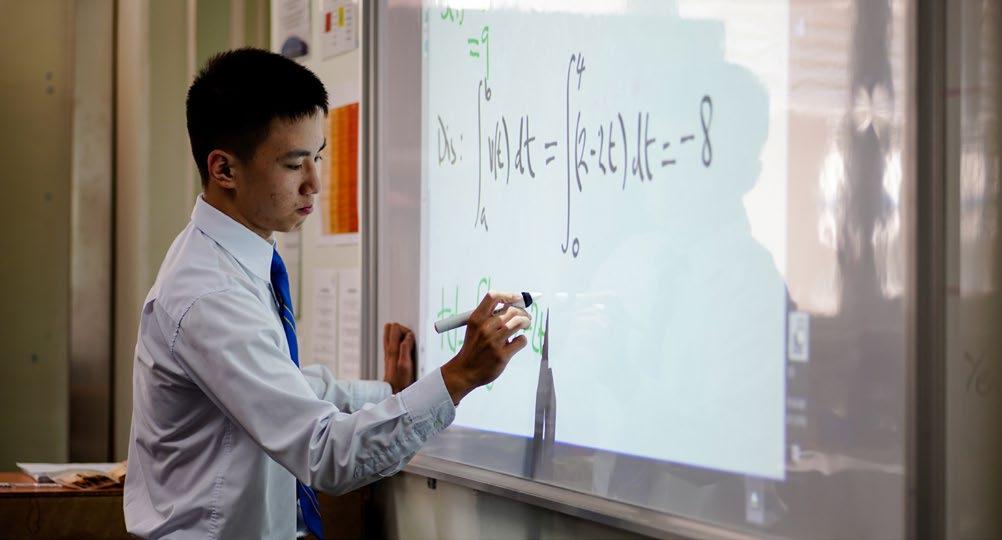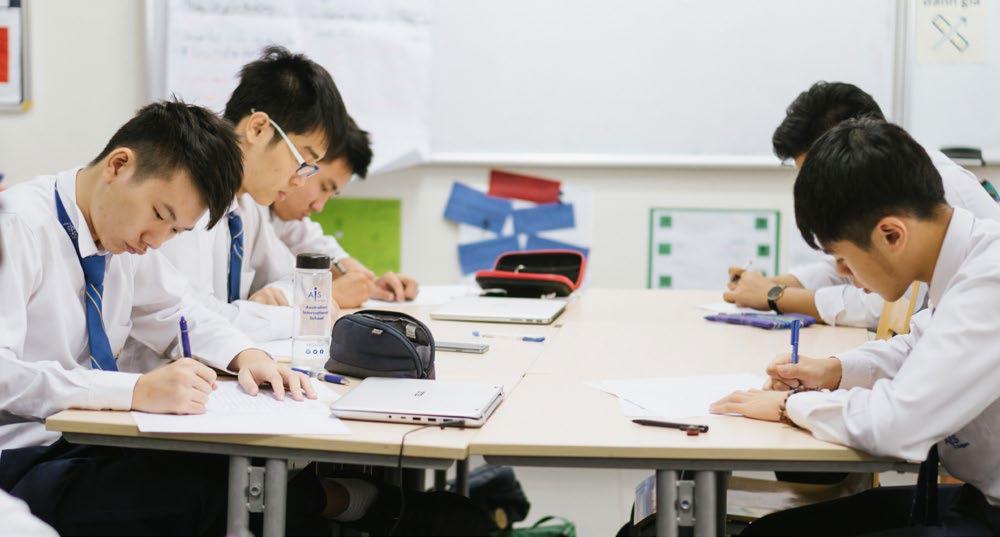
3 minute read
Group 5 Mathematics
Students need to be challenged and perform well while also being comfortable and confident with the level of Mathematics they are learning. As a compulsory element of the DP, it is important that all students feel confident in the type of Mathematics and level they choose and that all achievements are celebrated.
There are four different courses in Mathematics. These courses are designed for:
Advertisement
• those who wish to study Mathematics in depth, either as a subject in its own right or to pursue their interests in areas related to Mathematics;
• those who wish to gain a degree of understanding and competence to understand better their approach to other subjects;
• those who may not as yet be aware how Mathematics may be relevant to their studies and in their daily lives. Great care should be taken to select the course that is most appropriate for an individual student. In making this selection, students are advised to take account of the following factors:
• their abilities in Mathematics and the type of Mathematics in which they can be successful
• their other choices of subjects within the framework of the Diploma Programme
• their academic plans, in particular the subjects they wish to study in future
• their choice of career
At the Australian International School we offer the following group 5 subjects:
• Mathematics: Applications and Interpretation (SL)
• Mathematics: Applications and Interpretation (HL)
• Mathematics: Analysis and Approaches (SL)
• Mathematics: Analysis and Approaches (HL)
Mathematics: Applications and Interpretation
Course description
Applications and interpretation SL and HL is appropriate for students who are interested in developing their mathematics for describing our world and solving practical problems. They will also be interested in harnessing the power of technology alongside exploring mathematical models. Students who take Mathematics: Applications and interpretation will be those who enjoy mathematics best when seen in a practical context. This subject is aimed at students who will go on to study subjects such as social sciences, natural sciences, statistics, business, some economics, psychology, and design, for example.
Prerequisite knowledge and prior learning (SL)
The SL course is accessible to students with almost any mathematical background. Students with a grade C at IGCSE (or equivalent) should be able to aim for high grades in this course.
Prerequisite knowledge and prior learning (HL)
Students who have studied IGCSE should have or be expecting to obtain a grade A/A* and be confident in algebraic manipulation. The key aspect is that students need to be comfortable and confident working with algebra (solving linear and quadratic equations, rearranging formulae), numbers (fractions, and decimals) and have a good level of mathematical knowledge.
Course content
• Number and algebra
• Functions
• Geometry and trigonometry
• Statistics and probability
• Calculus
Mathematics: Applications and Interpretation assessment:
External assessment (80%)
Mathematics: Applications and Interpretation will be assessed with two written papers both of which will require the use of the technology in the form of a graphical calculator. Paper 1 will consist of short questions and paper 2 will consist of longer questions. HL will also feature a paper 3 exam.
Internal assessment (IA – 20%)
The internal assessment task will be the same for both HL and SL and is based on a piece of research, which interests the student and models the type of mathematical activity undertaken in the modern world.
Mathematics: Analysis and Approaches
Course description
Analysis and approaches at SL and HL is appropriate for students who enjoy developing their mathematics to become fluent in the construction of mathematical arguments and develop strong skills in mathematical thinking. They will also be fascinated by exploring real and abstract applications of these ideas, with and without the use of technology. Students who take Mathematics: Analysis and approaches will be those who enjoy the thrill of mathematical problem solving and generalization. This subject is aimed at students who will go on to study subjects with substantial mathematics content such as mathematics itself, engineering, physical sciences, or economics for example.
Prerequisite knowledge and prior learning (SL)
Students who have studied IGCSE should have or be expecting to get at least a grade B and be reasonably confident with Algebra (solving equations, rearranging formulae), Numbers (fractions and decimals) and Trigonometry. Students who have studied Core level IGCSE will not have the required mathematical background for this course.
Prerequisite knowledge and prior learning (HL)
Students who have studied IGCSE should have or be expecting to obtain a grade A/A* and be confident in algebraic manipulation. The key aspect is that students need to be comfortable and confident working with algebra (solving linear and quadratic equations, rearranging formulae), numbers (fractions, and decimals) and have a good level of mathematical knowledge.

Course content
• Number and algebra
• Functions
• Geometry and trigonometry
• Statistics and probability
• Calculus
Mathematics: Analysis and Approaches assessment:
External assessment (80%)
Mathematics: Analysis and Approaches will be assessed with two written papers. Each paper will consist of a section A (short questions) and a section B (long questions). Paper 1 will be without the use technology and paper 2 will allow the use of a graphical calculator. HL will also feature a paper 3 exam.
Internal assessment (IA – 20%)
The internal assessment task will be the same for both HL and SL and will be based on a piece of research which interests the student and models the type of mathematical activity undertaken in the modern world.







